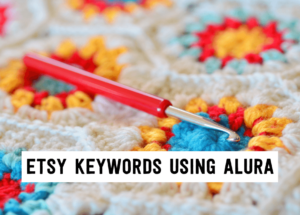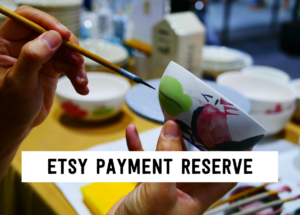
How to find the best Etsy keywords in 3 simple steps using Alura
If you want to be found in search results on Etsy, you need to optimize your product listing for SEO. And if you want to
join
join
Today’s video is inspired by the MANY emails I receive from makers every week, who are panicking because they’ve downloaded my free handmade pricing calculator, put their numbers in there, and the suggested retail price is HIGH.
Whether you’ve used my calculator or any other calculator or formula you might have found online, you might have found yourself in the same situation and thinking :
So the underlying thought here is “I won’t get any sales at that price point this isn’t a reasonable price”.
I totally understand those concerns, they’re very valid – you don’t want to price yourself out of the market, but at the same time – you also need to be making a profit right?
So let’s dive into it!
I’ve got 4 points to share with you that you should consider when you find yourself in this situation, with a price that you think is “too high” to see why that might be and how you can either reduce that price or make sure that people will buy at that price.
To start I’d just like to remind you that the one thing you’re not allowed to do when this happens, is to just put your prices down to what “feels” right to you.
That’s the best road to under-earning land and a sure way to not making this business work for you.
Instead, I want you to think through the 4 points I am about to share and really ask yourself: could this be what is happening here? There might be more than one thing at play too!
Number one is that even though YES, there is one and only one way to price your product correctly, there are many different formulas that can get you there.
The absolute, always true, north star of calculating and setting prices is this:
Cover cost + Add profit markup = You’ve got yourself your price.
But as I was saying, there are many different variations of that simple formula that you can and SHOULD customize to your specific business.
Calculating your costs is universal and the same for any business, but deciding on your markup isn’t. For that reason, there is no such thing as ONE pricing formula that would work for every shop.
And not only that, but despite every shop or every business having different markup strategy sometimes different products or different collections within your own shop might require a different markup strategy.
In the case of my free pricing calculator, I’ve deliberately chosen to use the formula that I know to be the most conservative, meaning the one that will give you the highest profit margin. I did this because I much prefer giving you a number that’s on the higher side – than a number on the lower side, because you don’t need anyone to do that, makers and creative shop owners are usually pretty good at under-charging, no help needed on that front!
But to give you an idea, when I actually work with makers on this – inside the Tizzit HQ we have a Handmade Pricing course as part of the curriculum – I give them not just ONE but 4 different formulas and then not only explain the difference between each but also teach them how to customize it further to work for their niche, their products and their goals.
So the first thing here: what formula did you use? Do you understand that formula and the markup strategy used in it? Is it the best suited for your specific type of products, goals and niche?
OK, let’s move on to point number 2, which is… taking a serious look at your costs.

e-com sales on tap training
simple step-by-step plan to grow your online store sales into a consistent and predictable income with the Reliable eCom Sales System
Reducing your costs has an important effect on the final price of your products, if the costs of creating your products are too high, it’s going to be hard to charge less without really compromising your profit margin. That’s just math.
There are 3 things to look at when considering if you can reduce your costs:
There are also many cases where the value of your products IS the level of care and attention to details you put into it, the craftsmanship and the process itself, the quality of your materials – and sometimes you just can’t cut corners on those. That’s not what your brand and the positioning you’re going for are about.
In that case your costs might be high but for good reasons as in they might be high, but at the same time, as low as you can get them. So instead of decreasing your costs, you need to increase the perceived value of your products.
Offering true value, true quality is by no means a guarantee of success. A great product will not sell itself, you have to communicate that value with your customers for this value to be perceived by them.
Branding, images, copy and messaging, packaging, social proof, storytelling… there are many levers you can pull here but lowering costs isn’t always the answer. Increasing perceived value can be, because then you’re able to sell your products at that higher price to customers who are delighted to pay that price.
Quick side note: Sometimes you can both decrease your costs AND increase your perceived value, which would mean more profit. It’s not just one or the other – so think about it and see what adjustments you can make ON ALL FRONTS.
OK now last but not least…
Number 4 is that… that price you’re seeing in your pricing calculator or that figure you got after calculating your cost and adding markup…. Maybe it’s NOT too high at all.
This is really not a business issue anymore but a business owner issue, and by that I mean, a mindset issue.
The vast majority of creative shop owners, makers, and artists I work with will 100% of the time convince themselves that their products are “not worth that much” based on nothing else than their own bias and limiting beliefs. Sprinkle a little bit of imposter syndrome on top and you’ve got yourself a shop that’s not turning a big enough profit.
And look, I am having a laugh, but we ALL do this. It’s very normal, but part of your job as a handmade business owner is to manage those self-sabotaging thoughts. It is something you can work on. I actually have an article on this, called “handmade pricing fears” I strongly recommend you read next.
My absolute best recommendation though if you need help with your Handmade Pricing Strategy, is to check out the full Handmade Pricing course.
Take care and until next time, aurevoir!
you might also like…
related articles

If you want to be found in search results on Etsy, you need to optimize your product listing for SEO. And if you want to

There has been a lot of talk in the Etsy community — and I mean A LOT of talk — about Etsy’s payment account reserve

Anyone who knows me knows that I am a HUGE advocate for using email marketing to grow and scale your handmade business. But you may
disclaimer
subscribe to youtube
THE LAUNCHPAD
get in touch
We acknowledge and give thanks to the Budawang and Yuin people, the Traditional Owners of the land we work and live on. We pay our respects to all Aboriginal and Torres Strait Islander Peoples and elders past, present and emerging.

learn how to grow your online store sales into a consistent and predictable income